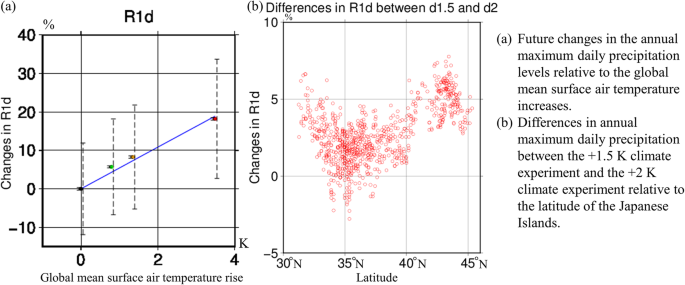当前位置:
X-MOL 学术
›
Prog. Earth Planet. Sci.
›
论文详情
Our official English website, www.x-mol.net, welcomes your
feedback! (Note: you will need to create a separate account there.)
Scalability of future climate changes across Japan examined with large-ensemble simulations at + 1.5 K, +2 K, and + 4 K global warming levels
Progress in Earth and Planetary Science ( IF 3.5 ) Pub Date : 2020-06-23 , DOI: 10.1186/s40645-020-00341-3 Masaya Nosaka , Masayoshi Ishii , Hideo Shiogama , Ryo Mizuta , Akihiko Murata , Hiroaki Kawase , Hidetaka Sasaki
Progress in Earth and Planetary Science ( IF 3.5 ) Pub Date : 2020-06-23 , DOI: 10.1186/s40645-020-00341-3 Masaya Nosaka , Masayoshi Ishii , Hideo Shiogama , Ryo Mizuta , Akihiko Murata , Hiroaki Kawase , Hidetaka Sasaki
Large-ensemble climate experiments were performed to simulate future climates for a + 1.5 K rise in the global mean surface air temperatures relative to preindustrial levels as a subset of the database for Policy Decision making for future climate change (d4PDF), using the Non-Hydrostatic Regional Climate Model (NHRCM) with 20 km grid spacing. Along with present climate, + 2 K and + 4 K experimental outputs from the d4PDF already available, we investigated responses of surface air temperature (SAT) and precipitation on regional scales over Japan to global warming. The reproducibility of the present climate experiment is satisfactory to investigate future changes in the Japanese climate, and dynamical downscaling from the global to the regional climate states improves the frequency of heavy daily precipitation. In the future, SAT over Japan rises linearly with and faster than the global mean SAT. The meridional contrast of SAT rises becomes more pronounced as global warming progresses. Winter precipitation decreases/increases linearly in the western/eastern Japan, reflected by weakening of future winter monsoons. Annual maximum daily precipitation (R1d) shows a closely linear increase with the global SAT rise, but annual precipitation is mostly unchanged. The global mean SAT change from + 1.5 to + 2 K enhances R1d by 2.7% over the Japanese Islands, although the increase of R1d varies by regions. The increase in R1d is 5% in northern Japan, where the SAT increases are greater than those in other regions.

中文翻译:

在全球变暖水平为+ 1.5 K,+ 2 K和+ 4 K的情况下,通过大型整体模拟研究了整个日本未来气候变化的可扩展性
进行了大集合气候实验,以模拟未来气候,将全球平均地表温度相对于工业化前的水平升高+ 1.5 K,作为未来气候变化政策决策数据库(d4PDF)的子集,网格间距为20 km的静水区域气候模型(NHRCM)。随着目前的气候,d4PDF已有的+ 2 K和+ 4 K实验输出,我们研究了日本各地表温度对全球变暖的地面气温(SAT)和降水的响应。当前气候实验的可重复性对于研究日本气候的未来变化是令人满意的,并且从全球气候变化到区域气候状态的动态降尺度可以提高日降水量的频繁程度。在将来,日本的SAT与全球平均SAT呈线性关系,并且比全球平均SAT更快。随着全球变暖的进展,SAT上升的子午对比变得更加明显。在日本西部/东部,冬季降水线性减少/增加,这反映了未来冬季风减弱。年最大日降水量(R1d)随全球SAT上升显示出紧密的线性增长,但年降水量基本保持不变。尽管日本平均SAT从+ 1.5更改为+ 2 K,但其R1d却增加了2.7%,尽管R1d的增加因地区而异。在日本北部,SAT的增幅大于其他地区,R1d的增幅为5%。在日本西部/东部,冬季降水线性减少/增加,这反映了未来冬季风减弱。年最大日降水量(R1d)随全球SAT的上升呈现出紧密的线性增长,但年降水量基本保持不变。尽管日本平均SAT从+ 1.5更改为+ 2 K,但其R1d却增加了2.7%,尽管R1d的增加因地区而异。在日本北部,SAT的增幅大于其他地区,R1d的增幅为5%。在日本西部/东部,冬季降水线性减少/增加,这反映了未来冬季风减弱。年最大日降水量(R1d)随全球SAT的上升呈现出紧密的线性增长,但年降水量基本保持不变。尽管日本平均SAT从+ 1.5更改为+ 2 K,但其R1d却增加了2.7%,尽管R1d的增加因地区而异。在日本北部,SAT的增幅大于其他地区,R1d的增幅为5%。尽管R1d的增加因地区而异,但比日本群岛高出7%。在日本北部,SAT的增幅大于其他地区,R1d的增幅为5%。尽管R1d的增加因地区而异,但比日本群岛高出7%。在日本北部,SAT的增幅大于其他地区,R1d的增幅为5%。
更新日期:2020-06-23

中文翻译:

在全球变暖水平为+ 1.5 K,+ 2 K和+ 4 K的情况下,通过大型整体模拟研究了整个日本未来气候变化的可扩展性
进行了大集合气候实验,以模拟未来气候,将全球平均地表温度相对于工业化前的水平升高+ 1.5 K,作为未来气候变化政策决策数据库(d4PDF)的子集,网格间距为20 km的静水区域气候模型(NHRCM)。随着目前的气候,d4PDF已有的+ 2 K和+ 4 K实验输出,我们研究了日本各地表温度对全球变暖的地面气温(SAT)和降水的响应。当前气候实验的可重复性对于研究日本气候的未来变化是令人满意的,并且从全球气候变化到区域气候状态的动态降尺度可以提高日降水量的频繁程度。在将来,日本的SAT与全球平均SAT呈线性关系,并且比全球平均SAT更快。随着全球变暖的进展,SAT上升的子午对比变得更加明显。在日本西部/东部,冬季降水线性减少/增加,这反映了未来冬季风减弱。年最大日降水量(R1d)随全球SAT上升显示出紧密的线性增长,但年降水量基本保持不变。尽管日本平均SAT从+ 1.5更改为+ 2 K,但其R1d却增加了2.7%,尽管R1d的增加因地区而异。在日本北部,SAT的增幅大于其他地区,R1d的增幅为5%。在日本西部/东部,冬季降水线性减少/增加,这反映了未来冬季风减弱。年最大日降水量(R1d)随全球SAT的上升呈现出紧密的线性增长,但年降水量基本保持不变。尽管日本平均SAT从+ 1.5更改为+ 2 K,但其R1d却增加了2.7%,尽管R1d的增加因地区而异。在日本北部,SAT的增幅大于其他地区,R1d的增幅为5%。在日本西部/东部,冬季降水线性减少/增加,这反映了未来冬季风减弱。年最大日降水量(R1d)随全球SAT的上升呈现出紧密的线性增长,但年降水量基本保持不变。尽管日本平均SAT从+ 1.5更改为+ 2 K,但其R1d却增加了2.7%,尽管R1d的增加因地区而异。在日本北部,SAT的增幅大于其他地区,R1d的增幅为5%。尽管R1d的增加因地区而异,但比日本群岛高出7%。在日本北部,SAT的增幅大于其他地区,R1d的增幅为5%。尽管R1d的增加因地区而异,但比日本群岛高出7%。在日本北部,SAT的增幅大于其他地区,R1d的增幅为5%。












































 京公网安备 11010802027423号
京公网安备 11010802027423号